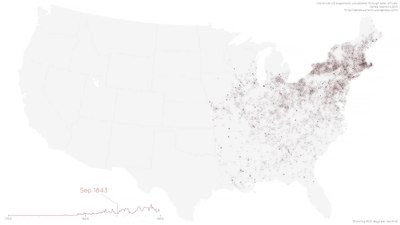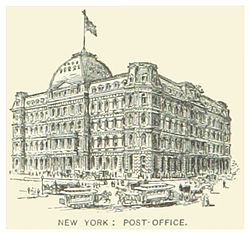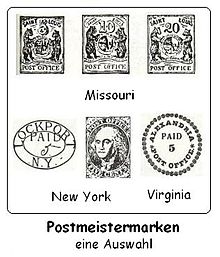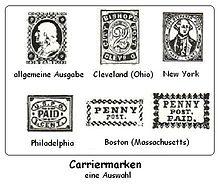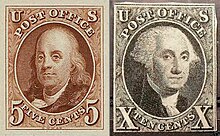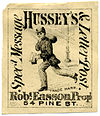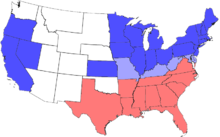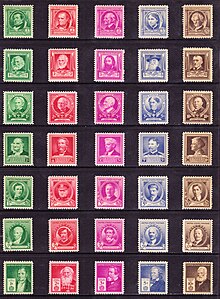Postal History and Postage Stamps of the United States
This article explores the diversity of the history of the US Postal Service .
Under British colonial administration
Little is known about the mail of the first settlers in America, up to 1693.
In 1639, citizen Richard Fairbanks was hired by the government agency in Boston , Massachusetts to deliver and move letters. For every letter he received a penny.
On December 10, 1672, under British colonial administration, the governor of the New York colony had a monthly mail connection between New York and Boston. The mail items received handwritten posting notes. In New York and other places, one- or two-line location stamps were introduced from 1756 and date stamps were used. There were postal connections between New York, Philadelphia, Boston and Portsmouth, with riders taking over the traffic irregularly. A letter from New York to Boston then cost 9 pence.
Fairbanks in Boston, Massachusetts was succeeded by Hayward in 1677. He became the first real “postmaster” and his office in the town hall became the first post office.
In 1683 William Penn set up a post office in Philadelphia with weekly mail connections to the area. In Virginia , in the second half of the 17th century, mail bags had to be forwarded to the general public; one settler had to send mail by messenger to the next. The attempt to create an orderly postal system remained limited and incoherent in scope.
The establishment of a Central Postal Organization began on February 17, 1691 when the British government gave Thomas Neale the exclusive right to exercise the postal service in the North American colonies for 21 years . Neale was chief of the Royal Mint in London. Postal laws were passed and thus the postage was determined. The aim was to establish post offices in every town in Massachusetts and Virginia and the other colonies. In 1692 Neale appointed New Jersey Governor Andrew Hamilton as American and West Indian Postmaster General with the task of establishing regular posts in the colony. Hamilton deserves the credit of having set up the Portsmouth – Philadelphia mail route on May 1, 1691 and maintaining it with great difficulty.

Through Queen Anne's Great Postal Act of 1710, American Post was taken over by the English Crown. Benjamin Franklin , who was Deputy Postmaster General of the New England States from 1753 to 1774 and an equally distinguished inventor as a statesman, introduced a penny post for location letters. So there was “Spaulding's Penny Post” between 1847 and 1850 in Buffalo and New York. In Baltimore, Maryland, Davis' Penny Post carried out 1856 mail for several weeks.
In 1763 the 475 miles from New York to Buffalo took four days and the 400 miles from London to Edinburgh seven days. The stagecoaches in America never drove at night. The country road system was well developed.
When the differences between the colony and the motherland broke out in 1773, Franklin was released from London. However, he remained in office.
The United States of America
During the struggle for independence, the first national congress on September 26, 1775 called the independent American post office into being. (See discussion) Congress made Philadelphia the seat of its headquarters and headed it by Benjamin Franklin. In 1775 the Falmouth to Savannah (Georgia) postal line was established. The first single-circle and place stamps appeared. In the period that followed, there was an abundance of stamp types. The fees were raised by 50 BC in 1777. H. and in 1779 increased to twenty times that of 1775. But as early as 1781, in the general interest, the fee rates were reduced to the state of 1775.
The Declaration of Independence of the United States of September 17, 1787 listed in Art. 1, Section 8, under the powers reserved to Congress, the establishment of post offices and postal lines and the enactment of the laws necessary for enforcement. It had been a principle since 1782 not to use the post office shelf as a source of finance; every surplus should be used to open new postal connections.
With the expansion of the transcontinental railroad network, postal traffic was also taken over on the main lines. Mail bags were thrown at small train stations without the train stopping.
| "Postal service in the years 1790 to 1850" | ||
| year | Number of post offices |
Length of the postal routes |
|---|---|---|
| 1790 | 75 | 1,900 miles |
| 1800 | 903 | 20,800 miles |
| 1825 | 5,677 | 94,100 miles |
| 1850 | 18,417 | 178,700 miles |
There are sources with different information, but they are very similar.
The postmaster general was in New York in 1789 , was housed in Philadelphia in 1792 and had his office in Washington, DC since 1800
The Postmaster General had been a member of the Cabinet since 1829. The postal service was an important part of the administration of the United States under the Central government . The postmasters did not have a salary but received a percentage of the money they received, the maximum of which could go up to $ 2,000 annually. The State Post was unable to meet all postal needs in the ever-growing country. Starting in 1839, this gap was filled by various private postal lines and agencies. They used their own stamps.
The Postal Expedition in New York in 1839 carried nearly 7 million letters in the first quarter of 1851.
Postmaster's stamps
After the introduction of a reduced, uniform postal tariff in 1845 and before the introduction of state stamp issues, locally valid, so-called postmaster's stamps at 5 cents for one zone and unit of weight of the letter were in use. Although the new official postage stamps were valid throughout the country, the postmaster and carrier stamps could still be used until the end of July 1847. This was also due to the delayed delivery of the official US postage stamps.
For St. Louis, Missouri, the values were 5, 10, and 30 cents. The brands of New York existed with different initials "ACM", "RHM" or "HMJr". The two-ellipse stamp "Lockport" is known only once on the letter.
Carrier brands
A stamp with the image of the president in an oval and the inscription “Carriers Mail” in orange-brown, from 1851 in blue on pink, was used to pay for the letter. Very few copies of the orange-brown stamp are known to this day; but there are reprints. Also in 1851 a stamp with the inscription "USPO Despatch" appeared. This stamp featured a soaring eagle. A declaration of value was not required for these stamps, delivery generally cost 1 cent.
USA postage stamps
The introduction of postage stamps in Great Britain in 1840 aroused great interest in the United States as well. A private service provider, Alexander M. Greig in New York City, set up a "City Despatch Post" on February 1, 1842. He issued his own postage stamps showing the portrait of George Washington . Just a few months after founding his company, Greig sold it to the US government and the post was now called the “United States City Despatch Post”. The government took over the postal service on August 16, 1842.
The "Act of Congress" of March 3, 1845, which came into force on July 1, 1845, stipulated uniform fees for the entire national territory with 5 cents for distances of less than 500 km. It was not until 1847 that the congress allowed the production of postage stamps, so that the postmasters usually made their own makeshift arrangements (see postmasters' stamps).
On July 1, 1847, the first postage stamps for 5 and X (10) cents were issued on the basis of a congressional resolution. They show the picture of Benjamin Franklin and George Washington and the inscription "Post Office". In 1851 another series of 1, 3, 5, X and 12 cents stamps and the inscription "US Postage" came out, again with pictures of presidents. These marks still had to be cut from the sheet with scissors. From 1875 these stamps were perforated. The values of 24, 30 and 90 cents were added as supplementary values, only provided with a perforation. At first most of the letters were franked in cash. Until January 1, 1856, when postage stamps were made mandatory,
Also in 1847 the American postal administration signed the first contract with a foreign government - Bremen - on the exchange of posts. On December 1, 1851, 16 steamers owned by the Post and four others were chartered in service.
For 1854, it is reported that, statistically, 1,000 Americans wrote 4,121 letters, compared with 14,760 in Great Britain.
The transport of the letter post (mail) was leased through contracts with private entrepreneurs (with express coaches (Stages)), or railway and steamship companies.
The Pony Express was, on the initiative of William Hepburn Russell , organized as an equestrian relay, mail delivery service in the United States. For some time it was the fastest postal connection in North America.
The post shelving was exercised to a very limited extent. The transport of people, parcels over 4 pounds, money or valuables were left to private companies. All railway lines and all shipping routes were classified as postal routes under a law of 1853. Only the postal administration was allowed to carry letters and newspapers on them. This also applied to international shipping. The captains who were not bound by a contract received 2 cents for each letter from abroad and 1 cents from within Germany. For them there was then double the domestic postage.
Confederate States of America (CSA)
The southern states comprised the southern United States during the Civil War years from 1861 to 1865.
On December 20, 1860, the founding state of the United States, South Carolina, declared its exit from the Union. The Confederate States of America (CSA) was founded on February 4, 1861. Jefferson Davis from Mississippi became Provisional President of the Confederate States of America. JH Reagan, who was appointed Minister of Post on March 6, 1861, did not get off to an easy start;
The outbreak of the American Civil War also affected the postal service, because on April 13, 1861, John H. Reagan (Postmaster General of the Confederate States of America) ordered the return of the American stamps to Washington DC. The USA declared their trademarks for the area of the CSA invalid from June 1, 1861. Such items were considered unpaid and were marked with the stamp "Southern Letter unpaid".
From May 1861, there were then its own CSA brands. Since many Confederate post offices were missing these new stamps for months, they switched to cash franking or spent makeshift arrangements. The cash franking is handwritten notes or stamps on the envelope to certify the payment of the postage.
In the north, new stamps appeared in August 1861 bearing the inscription "US". In 1863 there was a 2-cent stamp in black with a portrait of Andrew Jackson, known as "Black Jack". In 1866 a black 15 cents stamp with the portrait of Abraham Lincoln followed.
The first stamps of the CSA appeared in 1861/62 with the image of Jefferson Davis , and Thomas Jefferson , in variants and color variations. It was the first time that a living person could be seen on an American stamp. A total of 11 stamps at 2, 5 or 10 cents, with different colors, were issued. Local letters and printed matter cost 2 cents, letters up to 500 miles per ½ ounce, 5 cents, from July 1, 1862 10 cents, letters over 500 miles per ½ ounce 10 cents from 1 July 1862.
Before the secession of the southern states in the Civil War, the US Postmaster General was under 28,620 post offices. At the end of June 1863, 20,145 postal services were in service in the loyal states. 25 of them were cash registers (routing post offices). At the end of June 1865 there were 21,031 post offices and 7,851 offices in the south had to be newly established.
After the civil war
According to a law of March 3, 1863, the President appointed the postmasters of the 712 major post offices (annual salary over 1,000 dollars), all others were hired by the postmaster general. They had to be resident, take an oath of service, deposit a security deposit and swear the correctness of his bill every time.
A distinction was made between postage
- 1. Letters (3 cents per ½ ounce up to 300 miles, above 10 cents, for example for a letter from the east to the west coast), letters with money or valuables had to be recommended, registered,
- 2. Periodical publications according to the weight and frequency of their publication (between 1 × per week at 5 cents per quarter up to 35 cents if they appear seven times). They appear less than once a week and weekly papers within the county were free. Otherwise, 4 cents per 4 ounces counted.
- 3. Everything else was carried at 2 cents for 4 ounces each. B. 3 circulars counted as 4 ounces.
For letters to be forwarded, double the postage had to be paid. Since 1863, a double fee has also been levied for unfranked posted letters if there was no suspicion of postage evasion.
Registered mail has been possible since the law of March 3, 1863 (Section 32). With a surcharge of 20 cents, but no replacement was made in the event of loss.
As a result of the civil war , the law of July 24, 1861 and January 21, 1862 introduced postage exemption for both soldiers and sailors. This had become possible because there was a separate field post for the acceptance and delivery of such items.
The law of January 21, 1861 regulated the handling of undeliverable or unfranked items. The need had increased due to the civil war. A department for “dead letters” was set up for this purpose. Shipments were returned for 3 cents if they contained valuables. If a consignment had to be opened, for example to determine the address, the confidentiality of the letter was still granted. The secrecy of letters was restricted when the postmaster general issued a letter on August 4, 1845, according to which "writings and images against slavery" were not to be promoted, expanded in 1865 to "obscene books and pictures".
In large trading establishments of the Union there were branch post offices (law of March 3, 1847) and a city post office with a postage of 1 cent for the simple letter in addition to the main post office.

Postal stationery , both postcards, postal envelopes and wrappers have been sold since 1853 . From 1,000 pieces, under certain conditions, it was possible to determine the format and additional printing yourself. As in other countries, the demand was limited.
On July 1, 1863, the free delivery system was initially set up in cities with at least 50,000 inhabitants. On October 31, 1863, this service took place at 49 post offices. At the end of June 1864, mailboxes were set up at the post offices .
Newspaper brands
Newspaper stamps were used to offset the fees for the carriage of newspapers and newspaper packages. Only publishers or the newspaper trade could use these brands. The US Postal Service issued a total of 53 newspaper stamps between 1865 and 1895.
Official stamps
As in many countries, the postal administration of the US Postal Service was forced to issue special badges in order to limit the abuse of postage exemption. From July 1, 1873, nine ministries, the one for agriculture, for the correspondence of the president, the interior, the judiciary, the navy, the postal authorities, the foreign office, the treasury, the war ministry and the postal savings bank, received their own badges. From May 1, 1879, if a new delivery was required, they were replaced by special service envelopes. They were marked with an exemption from fees and a penalty for abuse. Such service envelopes are still in use today.
Since 1983 there have been official stamps again, valid for all departments. The last brands are from 1995.
Postage stamps
Between 1879 and 1985 a total of 70 postage stamps were issued. These postage stamps were used to offset the postage for inadequately franked letters. They were stuck on by a postman before the letter was delivered and charged by the postman when the letter was delivered. The postage fee was formerly called postage, the postage fee Franco.
Member of the Universal Postal Union
The United States of America was one of the founders of the Bern General Postal Association , which came into force on September 1, 1875.
Postal Money Orders
Postal orders were offered as early as 1792 by a private company in the United States.
The postal order service was officially introduced by law of May 17, 1864. The fee was staggered, from 1 to 10 dollars 10 cents, to 20 dollars 15 cents and up to a maximum of 30 dollars 20 cents. At the end of 1864, the facility had already been introduced in 420 post offices. In 1866 there were 2 levels, 1 to 20 dollars 10 cents and up to 50 dollars 20 cents.
A uniformly regulated international mail order traffic was first suggested by Germany at the Universal Postal Congress in Bern (1874). The first agreement concerning the postal order service came about at the Universal Postal Congress in Paris (1878). 14 states joined it. Due to special German agreements, postal orders were permitted in dealings with Great Britain and Ireland, Gibraltar, Malta, British India, the Dominium Canada and most of the other British possessions or British post offices in non-European countries, also to Hawaii, the Dutch possessions in the East Indies and the United States of America.
In the official gazette of the Deutsche-Reichs-Postverwaltung dated September 7, 1875, the rate for converting postal orders from the USA is given as 3 RM = 71 cents in gold. From April 1, 1880, international postal orders up to $ 50 were allowed. The fee was at least 40 pfennigs. The exchange rate: 100 dollars corresponded to 424 RM.
Post Office Savings Bank - Savings Bank
The United States Postal Savings System existed from January 1, 1811 to July 1, 1967.
According to the Congressional Act of June 25, 1910, the primary purpose of the institution was the deposit of interest-bearing savings under the guarantee of the state. No fees were charged, but the total credit could not be undercut. To achieve a higher interest rate, one could purchase Postal Savings Bonds. Because of its inflexible structure, an American post bank crisis occurred during the Great Depression . Many savers, especially poor savers, lost their money.
Packages
On January 1, 1913, a postal package service was established within the United States. 12 postage stamps with different motifs and the inscription "US PARCEL POST" were introduced. In 1928 another four stamps followed with numerical drawings with the inscription "SPECIAL HANDLING". A $ 1 stamp with the inscription "AIRLIFT" was issued in 1968 for American soldiers abroad.
In addition to the parcel stamps, there was a series of five postage stamps with the inscription "US PARCEL POST / POSTAGE DUE".
Previously, the United States Post Office only dealt with the delivery of postal parcels in traffic with foreign countries. In internal traffic, merchandise, etc., could only be sent by post up to 4 pounds (1 pound = 16 ounces = 453.6 g), before 1863 only up to 3 pounds. Parcel transport has been provided by freight companies, the Express Companies, since 1839, each of which had the exclusive right to express delivery on certain railway lines and could increase the fees at will. The late introduction of this branch of service is explained by the supremacy of the Express Companies, which have always fought against the admission of postal parcels.
The parcel post conference in Paris led to the conclusion of a parcel parcel agreement on November 3, 1880, which 19 countries joined and which came into force on October 1, 1881. Parcels are the parcels that are sent on the basis of the Parcel Agreement, a subsidiary agreement of the Universal Postal Union. Since September 11, 1899, the US has participated in this international package deal. At that time, RM 1.60 was payable for a package up to 1 kg, and 2.40 RM up to 5 kg.
Machine brands (ATM)
In a test phase between August 23, 1989 and May 7, 1990, two Autopost output devices were installed in Kensington and Washington. The devices had built-in scales and a postage calculator programmed for the domestic charges for letters and parcels. In addition to the country name and value, the printed ATMs contained a large number of other information.
For priority shipments over 11 ounces and parcels, there was an ATM where instead of the words “USA” the post office code entered by the customer on the screen was printed out both in digits and as a bar code. Most of all printed Autopost ATMs come from the dispatch point, all with the printing date on the first day. Machine stamps were equivalent to the usual postage stamps and were valid throughout the country.
For the Universal Postal Congress in Washington in 1989, two more machines were in use that delivered ATMs with the special location IDs 11 and 12. Letter from the Universal Postal Congress with ATM No. 11 and the special advertising field "Developed by Technology Resource Department" for this device.
In 1992 there was another operational test with a total of 30 stamp printers from the manufacturer Gard. The devices were again lavishly equipped with scales and postage calculators, and their appearance was reduced to a minimum. Indication of value in typewriter-like typeface on small horizontally perforated forms, which otherwise only show the small American state coat of arms.
Another experiment with 15 stamp printers from the US manufacturer Unisys with a significantly improved printing mechanism. The new ATM had a different perforation, a different typeface and a different national coat of arms, with plate number A11 on every 24th mark.
Between 1999 and 2001, self-adhesive machine stamps were used in various patterns, the appearance of which was more like postage stamps (with the date and barcode printed).
Telegraph system
The American telegraph lines are run as private companies. Since its introduction in 1844, the lines of electric telegraphs have been very popular.
In 1853 there were already 89 such lines with a length of 16,735 miles. They reached from the Canadian border to the Gulf of Mexico and connected all states up to the Mississippi and also those which lie on the right bank of this river.
Modern times
Series Famous Americans from 1940
The US Post Office issued a set of 35 stamps that were issued in 7 groups of 5 stamps and printed in 70 sheets. The publication took place over a period of about ten months. The 7 groups are designed to commemorate America's famous authors, poets, educators, scientists, composers, artists and inventors. Educators included Booker T. Washington, who was the first African American to be honored on a U.S. stamp. This series of Postage issues was printed by the Bureau of Engraving and Printing. These stamps were larger than regular, definitive issues, with only 280 stamp images on the printing plate (400 images were standard for the Presidential series). Also noteworthy is the red-purple color chosen for the 3 ¢ stamp, a lighter shade than the traditional purple. The stamps are colored according to their value: 1 cent green, 2 cents red, 3 cents purple, 5 cents blue and 10 cents brown. The frame of the stamp varies from group to group.
- Authors: Washington Irving - James Fenimore Cooper - Ralph Waldo Emerson - Louisa May Alcott - Samuel Clemens (Mark Twain)
- Poets: Henry Wadsworth Longfellow - John Greenleaf Whittier - James Russell Lowell - Walt Whitman - James Whitcomb Riley
- Educators: Horace Mann - Mark Hopkins - Charles W. Eliot - Frances E. Willard - Booker T. Washington
- Scientist: John James Audubon - Dr. Crawford W. Long - Luther Burbank - Dr. Walter Reed - Jane Addams
- Composers: Stephen Collins Foster - John Philip Sousa - Victor Herbert - Edward A. MacDowell - Ethelbert Nevin
- Artist: Gilbert Charles Stuart - James McNeil Whistler - Augustus Saint-Gaudens - Daniel Chester French - Frederick Remington
- Inventor: Eli Whitney - Samuel FB Morse - Cyrus Hall McCormick - Elias Howe - Alexander Graham Bell
From 1945
After the Second World War, there were numerous special stamps, which led to an abundance of issues.
The 3-cent standard postage for 1st class, which has been valid since 1933, was increased to 4 cents in 1958 until it had risen to 42 cents on May 12, 2008.
In 1971 the postal administration was reorganized and became the United States Postal Service (USPS).
The first self-adhesive stamps appeared around Christmas 1974. They were not particularly successful.
The increasing use of e-mail since the 1990s has led to a decrease in the volume of letters, while the volume of parcels continues to increase.
literature
- Rackow. inter alia: Manual dictionary of the postal system , published by the Federal Ministry for the Post and Telecommunications System, Frankfurt am Main 1953, pp. 731–733.
- Otfried Brauns-Packenius: From coast to coast. Postal history in the USA. In: Das Archiv issue 1/2004, pp. 34–43.
- Steven. W .: International tariffs for letter and parcel post 1875 - 1900 , self-published, Braunschweig 1986.
- Confederate States Philately. In: expertise Publisher: Deutsche Post AG, Edition 3/2011, pp. 4–7.
See also
- ZIP code US postcodes
- US Post Office US Post Offices
- US Post Office and Courthouse US post office building
- United States Postmaster General
- United States Postal Inspection Service
- Field post
- American field post in Germany after the First World War 1918–1935
- Allied field post in Germany after 1945
- Royal Mail - UK Postal Service
- Postal abbreviations for US states
Web links
Individual evidence
- ^ Gerstner, (Ritter von) Franz Anton: "Report from the United States of North America", Leipzig August 1839
- ↑ a b http://www.phila-gert.de/usbm/usbm_vorlaeufer.html
- ↑ http://www.briefmarkensammler-verein-goettingen.de/Artikel/Buergerkrieg%20Amerika.pdf ( page no longer available , search in web archives ) Info: The link was automatically marked as defective. Please check the link according to the instructions and then remove this notice.
- ↑ Dr. Carl Hock (Freiherr): "Finances and the financial history of the United States of America", Stuttgart, 1867
- ↑ 1940 Famous Americans Series on hobbizine.com , accessed November 12, 2018
